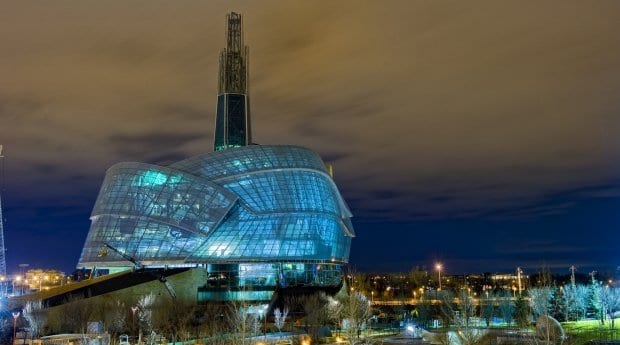Armando Perla fled to Canada 14 years ago from war-torn El Salvador after he was targeted for opening a clinic to teach his fellow countrymen and -women about their constitutional human rights.
Now, the researcher and curator at the first national museum to open in Canada since 1967 is about to help educate people about human rights on a scale he could never have imagined all those years ago as an activist in Central America.
The Canadian Museum for Human Rights (CMHR), which is set to open in Winnipeg on Sept 20, is being billed as the largest global centre dedicated to sharing knowledge about human rights in Canada and around the world.
Preparing for the opening of the museum — especially on content related to LGBT rights — has been particularly personal for Perla, who came out after he arrived in Winnipeg as a refugee in 2000. “It was something I assumed I always had to hide,” he says. “I was exposed to media and knew there were certain countries that were more open, but it just never occurred to me that I was going to be able to live my life the way that I wanted — that was sort of an added bonus of coming here, besides being able to flee the country and survive.”
After arriving in Winnipeg, Perla says, he soon made gay friends and straight friends and learned his sexuality really wasn’t a big deal. “My sexual orientation wasn’t something that was defining who I was. It was part of who I was, but it wasn’t everything. I will always be thankful to this country because of that.”
As one of its lead curators, Perla has ensured the museum will highlight accounts like his own, including in an exhibit about refugees that features the story of gay refugee Arsham Parsi, the founder of Iranian Railroad for Queer Refugees, a Toronto-based organization that helps bring persecuted LGBT refugees to Canada.
CMHR, which was the brainchild of the late Winnipeg media mogul Izzy Asper, will also include dozens of other stories connected to LGBT rights, including a dedicated exhibit about the fight for same-sex marriage in Canada. Other exhibits include material about the persecution of gay people in Nazi Germany, the Stonewall riots, Harvey Milk and the history of gay resistance during the Cold War.
It’s a cross-section of LGBT-related examples that’s sure to be equally lauded and criticized, a reality acknowledged by Jodi Giesbrecht, the museum’s acting manager of research and curation.
“The process of developing the content has been ongoing for many, many years,” says Giesbrecht, who, along with other staff, hosted consultations across the country with more than 2,000 people about what stories they wanted to see showcased in the museum.
Even though curators have 47,000 square feet of exhibit space to fill, she says, they often got bogged down in specific details, such as over one photograph and how it might be displayed. “With the constraints of schedules and budgets, there are certain stories that we’ve not been able to include,” she says.
For instance, the museum will not feature an exhibit on gay Canadian pioneers Svend Robinson, Jane Rule or George Hislop. And while curators have dedicated space to the Stonewall riots, they didn’t accentuate the watershed Canadian bathhouse raids of the 1980s. “I don’t think it was a conscious decision to not treat that explicitly,” Giesbrecht says, noting that curators aimed to keep the exhibits grounded in rights. “That’s why you do see a lot of the stories tied to court cases or specific human rights issues.”
Perla adds that while there is no one section dedicated to the bathhouse raids, they do feature in an exhibit about the decriminalization of homosexuality in Canada. “We’re trying to be sex-positive, and that’s some of the stories that we want to show,” he says.
Gary Kinsman, author of The Canadian War on Queers: National Security as Sexual Regulation, says he’s pleased to see the museum is highlighting lesbian, gay and queer struggles. “This is remarkably absent from most museums [in Canada], and this perpetuates the social organization of forgetting our experiences and struggles.”
Kinsman won’t comment on the quality of the queer content until the museum opens this fall, but another academic has raised concerns about political censorship at CMHR, which has been funded partially by the federal government.
In March, historian Veronica Strong-Boag criticized the Conservative government’s record on women’s rights in a blog post for CMHR that museum staff posted but then later removed. “I was told it was brought down because communications at the museum had some problems with what it contained,” Strong-Boag told CBC, which noted that a spokesperson for the museum said its blogs are not to be used as a political platform. “I’m very disappointed . . . I think Canadians have every reason to expect a much better approach by a museum that is funded on our dollars to a significant degree.”
It wouldn’t be the first time the Conservative government has influenced a federally funded museum to remove content. In 2012, the Canada Science and Technology Museum in Ottawa bowed to pressure from then–heritage minister James Moore and removed content about masturbation from an exhibit about sex.
But Maureen Fitzhenry, the CMHR’s media relations manager, says the Winnipeg museum is arm’s length as a Crown corporation and its staff members answer to its board of directors, whose role is to align content with the museum’s mandate. “Ideology will not be an influence,” Fitzhenry says. “People will see it through their ideology, but we have to be careful that we’re not sort of all the other way, either. The human rights community tends to come at it from a very leftwing kind of ideology, so there’s a danger that we can be taking a very leftwing radical perspective as well. So we have to be careful that we’re looking at [exhibit content] from multiple perspectives in an inclusive Canadian way.”
For his part, Perla says he’s never been pressured to censor content linked to sexuality or gay rights, but he expects Canadians will find plenty of the museum’s content controversial when its doors open later this year. But he says that’s also the point — the museum’s stated mission is to encourage reflection and dialogue.
It’s one of the qualities the former refugee found most compelling about Canada when he first arrived: a realization that while our country is advanced when it comes to human rights and gay rights issues, everyone is still allowed an opinion.
Perla recalls dealing with a homophobic colleague at his first Canadian job. “There’s this person who’s very religious and she’s around my age, and she says to me, ‘You know that what you’re doing is wrong; you’re going to go to hell.’ I remember crying, ’cause everything’s so fresh, and I was coming from a very repressive society. And then being in Winnipeg and having experienced that freedom and then having someone shatter all of that, and realizing that there are people like that here, too — and it doesn’t matter where you go; there’s always going to be people like that.”
It’s a message that those preparing one of the most ambitious cultural projects in Canadian history can agree on: the fight for human rights is messy and often bloody, but we grow better with each battle.
“The whole idea of the museum isn’t to commemorate or glorify any community, including the LGBT community,” Fitzhenry says. “But rather what can we learn from the experiences of the LGBT community that help us better understand human rights for all.”
Building blocks of change for an increasingly cool Winnipeg
The content of the museum is important, but the massive project is also notable for architectural reasons.
“It’s now our money shot,” Gillian Chester, manager of communications at Tourism Winnipeg, says of the museum, whose Tower of Hope rises about 30 storeys, 23 metres higher than the iconic Golden Boy statue on Manitoba’s legislative building.
Architects also designed the massive building with environmental sustainability in mind: for example, 50 percent of water in the museum’s toilets will come from rainwater collected on site. The museum also contains more than 175,000 individual pieces of limestone, basalt and alabaster; the limestone from quarries in nearby Tyndall, Manitoba.
The scale of the building is also impressive: it’s the size of four football fields over five main levels, three mezzanine levels and finally the triumphant — and vertigo-inducing — Tower of Hope, which guests can climb in order to look down at the museum’s intricate ramp system and open-concept galleries and offices.
Architect Antoine Predock won the 2005 international competition to design the museum because of the different human rights elements that he incorporated into the design, Lindsey Weedon, the museum’s communications and public engagement advisor, told Xtra last year during a media tour of the facility. First there are the four stone “roots” of the building that indicate humankind’s connection to Mother Earth. They also ensure that guests entering the museum feel as if they’re walking into the earth or into a deep cave. The museum also features a “garden of contemplation” where guests can pause as they wander through the museum to take a few moments to contemplate the often heavy material, such as galleries dedicated to the Holocaust and other genocides, as well as stories from indigenous people.
Weedon says 60 percent of the museum’s content is digitally delivered, which will allow for updating as new information becomes available. The museum also has a gallery that will serve as a rotating space in order to feature fresh content for return guests.
The groundbreaking museum is one of several large projects that Tourism Winnipeg’s marketing director, Cody Chomiak, says is “heating up the water” in Manitoba’s capital. The Winnipeg zoo is set to launch a new northern species exhibit called Journey to Churchill, and the city recently inaugurated a brand new football stadium.
Often recognized for negative reasons, including cold weather, mosquitoes and gang violence, the prairie city of 700,000 has been receiving an increasing amount of positive attention of late. This includes an arts feature in The Globe and Mail in June that noted Winnipeg is seeing “an architectural rebirth” and an enthusiastic travel review in Australia’s Sydney Morning Herald that referred to Winnipeg as an “extraordinary city” and “an epic riddle that’s fresh and intriguing, a surprise package that will leave you delighted at having made the discovery.”
“We’re like a lobster that doesn’t know the water’s boiling,” Chomiak says. “A little bit at a time, and then all of a sudden we’re going to turn around and say, ‘Hey, it’s really hot in here.’ I think that’s what’s going to happen. The museum’s going to open, all these other things are going to come to fruition, and then the Winnipeggers are going to turn around and say, ‘Hey, this is really great, there is a lot of stuff going on.’”
Read more about gay life in Winnipeg.


 Why you can trust Xtra
Why you can trust Xtra


